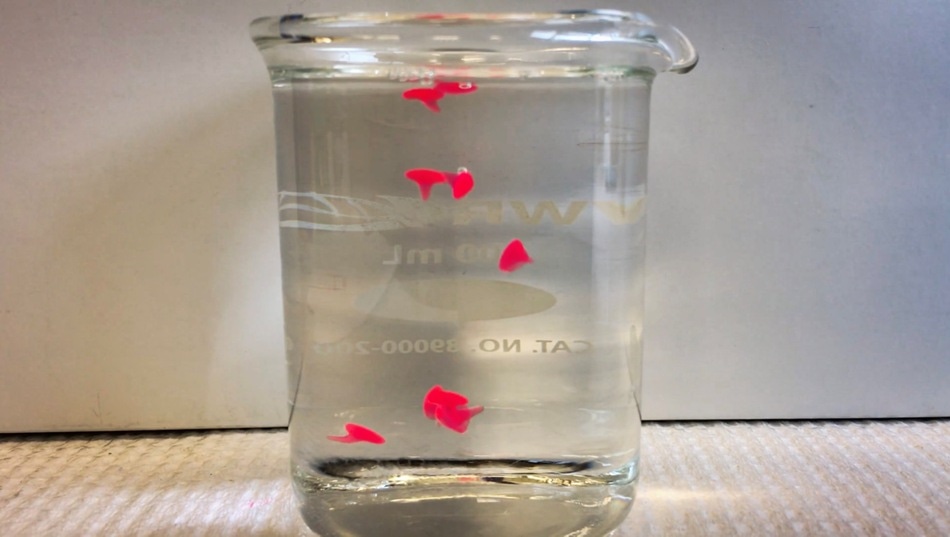Jun 24 2019
Chemical engineers at MIT have developed a novel method for producing extremely small droplets of liquid suspended inside another liquid, referred to as nanoemulsions.
 MIT chemical engineers have devised a way to convert liquid nanoemulsions into solid gels. These gels (red) form almost instantaneously when drops of the liquid emulsion enter warm water. (Image credit: MIT)
MIT chemical engineers have devised a way to convert liquid nanoemulsions into solid gels. These gels (red) form almost instantaneously when drops of the liquid emulsion enter warm water. (Image credit: MIT)
Emulsions like that are analogous to the mixture that forms upon shaking a salad dressing containing vinegar and oil, but with relatively tinier droplets. Due to their extremely small size, emulsions continue to be stable for a comparatively long duration of time.
The scientists also identified a method in which the liquid nanoemulsions can be easily changed into a gel as soon as they achieve a body temperature of 37 °C. This approach may prove handy for creating materials that are capable of delivering medication when administered into the body or rubbed against the skin.
The pharmaceutical industry is hugely interested in nanoemulsions as a way of delivering small molecule therapeutics. That could be topically, through ingestion, or by spraying into the nose, because once you start getting into the size range of hundreds of nanometers you can permeate much more effectively into the skin.
Patrick Doyle, Study Senior Author and the Robert T. Haslam Professor, Department of Chemical Engineering, MIT
In their latest research, which was reported in the June 21st issue of Nature Communications, the scientists produced nanoemulsions that remained stable for over a year. In order to show the potential usefulness of emulsions for delivering drugs, the team demonstrated that ibuprofen could be integrated into the droplets.
Former MIT postdoc Seyed Meysam Hashemnejad is the study’s first author. Other authors include L’Oréal senior scientist Brady Zarket, former postdoc Abu Zayed Badruddoza, and former MIT summer research intern Carlos Ricardo Castaneda.
Energy reduction
Adding energy is one of the easiest methods to produce an emulsion—for instance, by shaking the salad dressing, or utilizing a homogenizer to break down fat globules present in milk. The droplets will be smaller and more stable if the amount of energy that goes in is more.
Nanoemulsions, which include droplets with 200 nm or smaller diameters, are generally preferred because they are more stable and also possess a higher ratio of surface area to volume. This enables nanoemulsions to carry larger payloads of active ingredients like sunscreens or drugs.
In the past several years, Doyle’s laboratory has been working on lower-energy strategies for creating nanoemulsions, which can possibly make the process simpler to adapt to massive industrial manufacturing.
The formation of emulsions can be accelerated by detergent-like chemicals known as surfactants; however, several surfactants that have earlier been used for producing nanoemulsions have not been approved by the FDA for use in humans. As a result, Doyle and his students selected a pair of surfactants that are uncharged, which means they are less liable to irritate the skin, and have been already approved by the FDA as either cosmetic or food additives.
The team also added a negligible amount of a biocompatible polymer—polyethylene glycol (PEG)—used for delivering drugs and supports the solution to create even tinier droplets, as small as 50 nm in diameter.
With this approach, you don’t have to put in much energy at all. In fact, a slow stirring bar almost spontaneously creates these super small emulsions.
Patrick Doyle, Study Senior Author and the Robert T. Haslam Professor, Department of Chemical Engineering, MIT
Prior to the formation of the emulsion, active ingredients can be blended into the oil phase so they end up being loaded into the emulsion droplets.
As soon as the researchers had created a low-energy technique to produce nanoemulsions, utilizing nontoxic ingredients, they added a step that would enable the emulsions to be easily changed into gels upon reaching body temperature. This feat was accomplished by integrating heat-sensitive polymers known as Pluronics, or poloxamers, which have been already approved by the FDA and is utilized in certain cosmetics and drugs.
Three “blocks” of polymers are present in Pluronics—the middle region is somewhat hydrophobic, while the outer two regions are hydrophilic. Although these molecules dissolve in water at room temperature, they do not interact considerably with the droplets forming the emulsion. Yet, when the hydrophobic regions are heated, they easily adhere to the droplets, causing them to pack together more compactly and producing a solid that looks like jelly. This process occurs within seconds, that is, as soon as the emulsion is heated to the required temperature.
Tunable properties
The investigators discovered that the characteristics of the gels, including the temperature at which the material gets converted into a gel, could be tuned by altering the emulsion droplets’ size as well as the structure and concentration of the Pluronics which they introduced into the emulsion. Traits like yield stress, which is a measure of the amount of force required to spread the gel, and elasticity can also be modified.
Currently, Doyle is looking for means to integrate an array of active pharmaceutical ingredients into this gel type. Products like that can possibly be administrated to create a “drug depot” that would harden within the body and discharge drugs over a long time period, or they might be helpful for delivering topical medications to heal burns or other kinds of injuries. In addition, such droplets could be made sufficiently small to be used in nasal sprays for delivering drugs that can be inhaled, stated Doyle.
This method could be used in cosmetic applications for producing a range of products, including moisturizers, that feel smoother on the skin and are more shelf-stable.
L’Oréal funded the study.